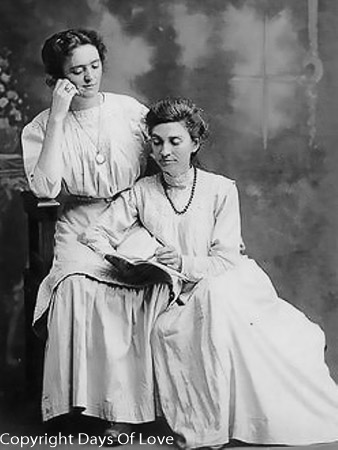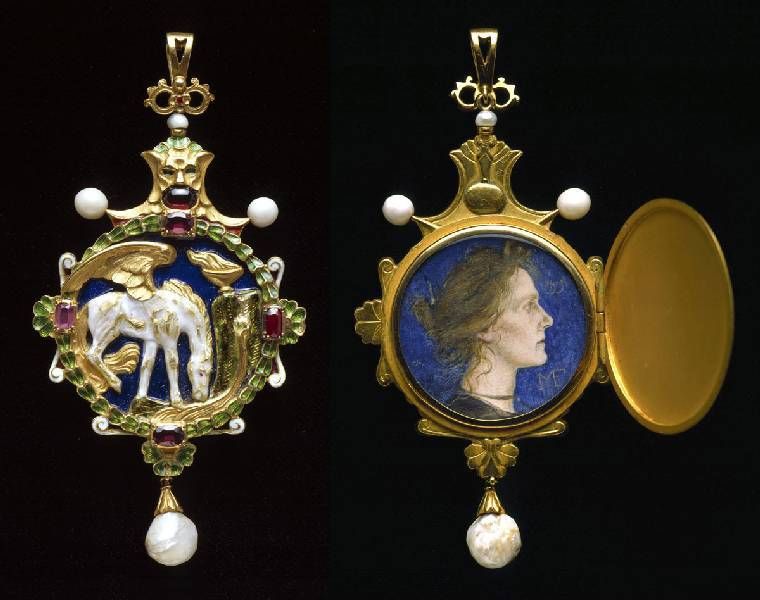

Partner Katherine Harris Bradley, buried together
Queer Places:
The Bingham, 61-63 Petersham Rd, Richmond TW10 6UT, Regno Unito
13 Well Walk, Hampstead, London NW3 1BY, UK
Blackboro' Lodge, 81 Reigate Rd, Reigate RH2 0RE, UK
Stoke Green, Bristol
St Mary Magdalen, 61 N Worple Way, Mortlake, London SW14 8PR, Regno Unito
.jpg) Michael
Field was a pseudonym used for the poetry and verse drama of Katherine Harris Bradley
(27 October 1846 – 26 September 1914) and her niece and ward Edith Emma
Cooper (12 January 1862 – 13 December 1913). As Field they wrote around 40
works together, and a long journal Works and Days. Their intention
was to keep the pen-name secret, but it became public knowledge, not long
after they had confided in their friend
Robert
Browning.
Kathering Bradley and Edith Cooper
formed an emotional and writing partnership. Katherine was Edith's aunt
and the two women had grown up in the same household. In 1878, Edith
joined Katherine at University College, where they both studied classics
and philosophy. Both women were feminists and rejected their female names
as a symbol of their rejection of subordinate female roles. Both women
regarded their relationship as a marriage and, in 1907, converted to Roman
Catholicism in the hope of being reunited in an alterlife. The two died
less than a year apart, with Katherine nursing Edith through cancer until
Edith's death in December 1913, before herself dying of cancer in 1914.
Michael
Field was a pseudonym used for the poetry and verse drama of Katherine Harris Bradley
(27 October 1846 – 26 September 1914) and her niece and ward Edith Emma
Cooper (12 January 1862 – 13 December 1913). As Field they wrote around 40
works together, and a long journal Works and Days. Their intention
was to keep the pen-name secret, but it became public knowledge, not long
after they had confided in their friend
Robert
Browning.
Kathering Bradley and Edith Cooper
formed an emotional and writing partnership. Katherine was Edith's aunt
and the two women had grown up in the same household. In 1878, Edith
joined Katherine at University College, where they both studied classics
and philosophy. Both women were feminists and rejected their female names
as a symbol of their rejection of subordinate female roles. Both women
regarded their relationship as a marriage and, in 1907, converted to Roman
Catholicism in the hope of being reunited in an alterlife. The two died
less than a year apart, with Katherine nursing Edith through cancer until
Edith's death in December 1913, before herself dying of cancer in 1914.
Katharine Bradley was born on 27 October 1846 in Birmingham, England, the daughter of Charles Bradley, a tobacco manufacturer, and of Emma (née Harris). Her grandfather, also Charles Bradley (1785–1845), was a prominent follower and financial backer of prophetess Joanna Southcott and her self-styled successor John "Zion" Ward.[1] She was educated at the Collège de France and Newnham College, Cambridge.


Charles de Sousy Ricketts (1866-1931), Pegasus Drinking from the
Fountain of Hippocrene (1901), Locket designed for Edith Cooper (aka
Michael Field), containing the portrait of Katherine Bradley
Stoke Green
Bradley's elder sister, Emma, married James Robert Cooper in 1860, and went to live in Kenilworth, where their daughter, Edith Emma Cooper was born on 12 January 1862. Emma Cooper became an invalid for life after the birth of her second daughter, Amy, and Katharine Bradley, being her sister, stepped in to become the legal guardian of her niece Edith Cooper.[2]
Bradley was for a time involved with Ruskin's utopian project. She published first under the pseudonym Arran Leigh, a nod to Elizabeth Barrett. Edith adopted the name Isla Leigh for their first joint publication, Bellerophôn.
From the late 1870s, when Edith was at University College, Bristol, they agreed to live together and were, over the next 40 years, lesbian lovers,[3] and co-authors. Their first joint publication as Michael Field was "Callirhöe and Fair Rosamund" in 1884. They had financial independence: Bradley's father Charles Bradley had been in the tobacco industry in Birmingham.
They were Aestheticists, strongly influenced by the thoughts of Walter Pater. They developed a large circle of literary friends and contacts; in particular painters and life partners Charles Ricketts and Charles Shannon, near whom they settled in Richmond, London. Robert Browning was also a close friend of theirs, and they knew and admired Oscar Wilde, whose death they bitterly mourned. While they were always well connected, the early critical success was not sustained (this is often attributed to the joint identity of Field becoming known). They knew many of the aesthetic movement of the 1890s, including Walter Pater, Vernon Lee, J. A. Symonds and also Bernard Berenson. William Rothenstein was a friend. In 1899 the death of Edith's father enabled them to buy their own house as evidence of their "close marriage", although Edith saw her father's death as retribution for their lifestyle. Edith led the way in establishing the couple as active Catholics.[4]
They wrote a number of passionate love poems to each other, and their name Michael Field was their way of declaring their inseparable oneness. Friends referred to them as the Fields, the Michaels or the Michael Fields. They had a range of pet names for each other. They also were passionately devoted to their pets, in particular a dog named Whym Chow, for whom they wrote a book of poems named after him.
Their joint journal starts with an account of Bradley's passion for Alfred Gérente, an artist in stained glass and brother of Henri Gérente, who was of an English background but worked mostly in France. It goes on to document Michael Field as a figure, amongst 'his' literary counterparts, and their lives together. When Whym Chow died in 1906, the emotional pattern of the relationship was disturbed; both women became Roman Catholic converts in 1907. Their religious inclinations are reflected in their later works, where their earlier writing is influenced by classical and Renaissance culture, in its pagan aspects particularly, Sappho as understood by the late Victorians, and perhaps Walter Savage Landor.
Edith died of cancer in 1913, as did Katherine less than a year later. They were buried together at St Mary Magdalen Roman Catholic Church Mortlake. A now-lost marble tomb was erected in 1926. Their extensive diaries are stored in the British Library,[4] and have been digitised and made available by the Victorian Lives and Letters Consortium.[5]
A much-edited selection from the journals, which were two dozen annual volumes in ledgers with aspects of scrapbooks combined with a self-conscious literary style of composition, was prepared by T. Sturge Moore, a friend through his mother Marie.
My published books: